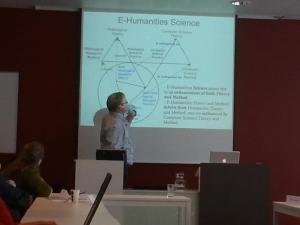Electronic Tools in Biblical Hebrew Teaching and Research
Workshop, Amsterdam, 2–3 May 2013
The ETCBC database of the Hebrew Bible

Over the last decades, the Research Group for IT and Biblical Studies at VU University, Amsterdam has created a database of the Hebrew Bible (Old Testament), which includes morphological encoding, clause segmentation and clause parsing, clause relations and proposals for a text syntactical analysis. It has become an extremely rich resource for Biblical Hebrew teaching and research. In his inaugural lecture at the end of the workshop Prof. Wido van Peursen announced the new name of this research group, formerly know as the “Werkgroep Informatica (WIVU)”: the Eep Talstra Centre for Bible and Computer. Consequently, the database was renamed as the ETCBC database of the Hebrew Bible.
Building a bridge
The workshop was intended to face the challenge to build a bridge between (a) the potential of IT to reshape research strategies and teaching methods and (b) traditional linguistic and literary research on the Bible. Many biblical scholars are satisfied by IT as an instrument to make life more comfortable (a library on the screen instead of on the shelves; a quick word search replacing consulting a printed concordance), without realizing the potential of the electronic instruments for redefining our research and teaching practices. The aim of the symposium was to build such a bridge. It focused on the Hebrew database of the ETCBC and its potential in teaching and research.
Programme
The workshop included two hands-on workshop sessions in which various applications of the ETCBC database were demonstrated. Both workshop sessions contained a response by a scholar/teacher, who served as representative of the intended audience.
Hands-on sessions
Prof. Eep Talstra gave the first workshop, entitled “The Bible as Data. Attempts to Proceed from Linguistic Analysis to Literary Reading” This workshop dealt with the potential of the database of the ETCBC for developing new research strategies. The other workshop, entitled ‘Corpus-Driven, Self-Directed Persuasive Learning’, was directed by Nicolai Winther-Nielsen (Aalborg University, Denmark). This workshop dealt with the Open Educational Resources developed in the EU project EuroPLOT, which incorporates the ETCBC database of the Hebrew Bible. Responses were presented by Prof. Joep Dubbink (VU University) for the first workshop and Dr Oliver Glanz (VU University) for the second workshop.
Seminars
In addition to the two workshops, two seminars were conducted dealing with methodological questions. Seminar 1, “Verb Valence: Programming, Linguistics and Literary Analysis”, included presentations by Dr Ulrik Sandborg-Petersen (Aalborg University), Dr Oliver Glanz (VU Amsterdam) and Dr Reinoud Oosting (Leiden University). Seminar 2, “Building and Using a Linguistic Database”, included papers by Dirk Roorda (DANS, The Hague) and Gino Kalkman (VU Amsterdam).
Inaugural lecture
At the start of the first day of the workshop, the participants were welcomed by the Vice-Dean of the Faculty of Theology, VU University, Prof. Eddy Van der Borght. At the end of the second day Prof. Wido van Peursen gave his inaugural lecture, entitled Grip op grillige gegevens. De exegeet als systematicus (in Dutch; click here for the text). He addressed the role that the computer can play in the systematic analysis and classification of textual phenomena both in the linguistic and in the literary analysis of the Bible.
Participants
The workshop was attended by 35 to 40 people, including PhD students, postdoctoral researchers, teachers and senior scholars in Old Testament and Hebrew linguistics. Most participants came from the Netherlands, some from other countries (Belgium, Denmark, USA).
Acknowledgements
The workshop has been made possible through the generous support of the European Association of Digital Humanities (EADH), the Netherlands School for Advanced Studies in Theology and Religion (NOSTER) and the Faculty of Theology of VU University.
